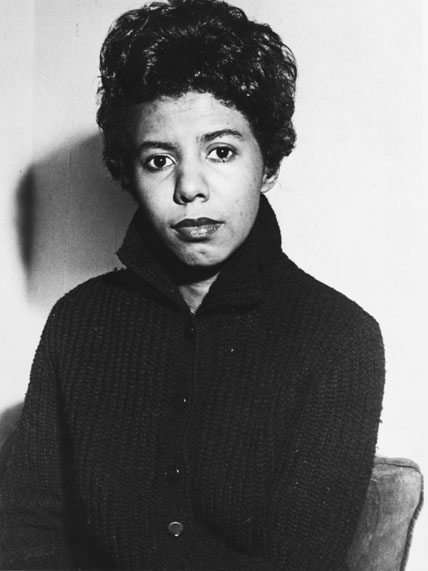
Unknown photographer. Portrait of dramatist Lorraine Hansberry, circa 1950s. Gelatin silver print. Photographs and Prints Division, Schomburg Center for Research in Black Culture, The New York Public Library, Astor, Lenox and Tilden Foundations

Unknown photographer. Portrait of dramatist Lorraine Hansberry, circa 1950s. Gelatin silver print. Photographs and Prints Division, Schomburg Center for Research in Black Culture, The New York Public Library, Astor, Lenox and Tilden Foundations

Unknown photographer. Dramatist Lorraine Hansberry at the time of her play A Raisin in the Sun opening in New Haven, Connecticut, prior to its run on Broadway, 1959. Gelatin silver print. Photographs and Prints Division, Schomburg Center for Research in Black Culture, The New York Public Library, Astor, Lenox and Tilden Foundations. Courtesy of Estate of Jewell H. Gresham Nemiroff

Washington Square strolling couple. Cover of The Ladder, April 1959. Courtesy of the Gay, Lesbian, Bisexual, Transgender Historical Society, San Francisco

“What Is the Truth? Vice Story.” Cover of The Ladder, November 1959. Courtesy of the Gay, Lesbian, Bisexual, Transgender Historical Society, San Francisco

Twice Militant: Lorraine Hansberry’s Letters to “The Ladder”
November 22, 2013–March 16, 2014
In the late 1950s, the fight for gay rights was developing alongside the growing Civil Rights and feminist movements. An important voice in the Civil Rights struggle was author, essayist, and activist Lorraine Hansberry (1930–1965), the award-winning playwright of A Raisin in the Sun. This exhibition explores a largely unknown but significant aspect of Hansberry’s biography connecting her to the gay rights movement: the letters she wrote in 1957 to The Ladder, the first subscription-based lesbian publication in the United States. In these provocative letters, Hansberry drew on her own identity and life experiences to articulate the interconnected struggles of women, lesbians, and African Americans during the period. She pointed to her identification with the burgeoning feminist movement in a 1959 interview with Studs Terkel, saying that “the most oppressed group of any oppressed group will be its women,” adding that those who are “twice oppressed” often become “twice militant.”
The exhibition includes approximately twenty-seven issues of The Ladder, beginning with the publication’s launch in 1956 and documenting its early underground years, under the waning force of the Comstock Act. (Under these laws, enacted in 1873, it was illegal to send “obscene, lewd, and/or lascivious” materials in the U.S. mail. Free press rights around homosexuality were granted in 1958.) Also included are Hansberry’s handwritten lists to herself on her birthdays, typewritten essays on “the homosexual question,” a poem titled “Le Masque,” and a notebook with a drawn self-portrait. There is also a listening station with Hansberry’s interview with Studs Terkel.
Twice Militant: Lorraine Hansberry’s Letters to “The Ladder” is the latest exhibition in the Herstory Gallery of the Elizabeth A. Sackler Center for Feminist Art, which is devoted to subjects that explore the significant contributions of the women named in The Dinner Party by Judy Chicago.
Twice Militant: Lorraine Hansberry’s Letters to “The Ladder” is organized by Catherine Morris, Sackler Family Curator for the Elizabeth A. Sackler Center for Feminist Art, Brooklyn Museum.
This exhibition is made possible by the Elizabeth A. Sackler Foundation.